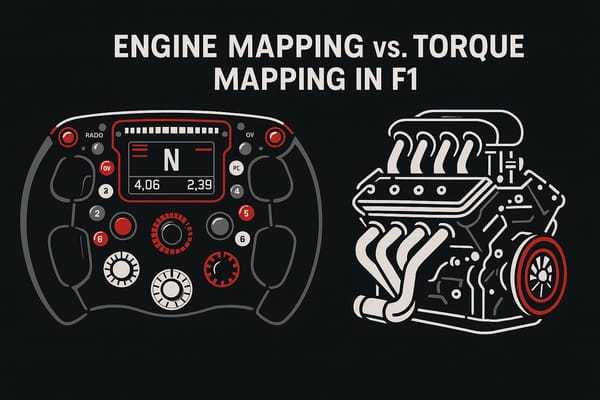Brabham F1 Team: Founding Years and Early Wins
Explore the founding years and early successes of a groundbreaking F1 team, highlighting innovative engineering and key victories.

The Brabham F1 Team is a story of racing ambition and engineering excellence. Founded in 1960 by Jack Brabham, a two-time Formula One World Champion, and Ron Tauranac, a skilled British-Australian engineer, the team quickly became a force in motorsport. Here’s what made their early years stand out:
- Jack Brabham's Unique Feat: In 1966, Jack Brabham became the only driver in F1 history to win a World Championship in a car bearing his own name.
- Innovative Engineering: Tauranac’s simple yet effective designs helped Brabham cars compete at the highest level. By 1970, over 500 cars had been built, making Brabham the largest producer of single-seat racing cars.
- First Wins: The team’s breakthrough came in 1964 with Dan Gurney’s victories at the French and Mexican Grands Prix.
- Customer Cars: Brabham prioritized quality, selling cars to customer teams that matched the performance of their works cars.
Brabham’s early success was driven by a combination of smart engineering, strong partnerships, and adaptability, laying the foundation for future championships.
The History Of Brabham F1 Team
How Brabham F1 Started
Brabham F1 was born from the determination of two Australians who shared a vision to transform the racing world with precision and ingenuity. This bold beginning laid the groundwork for the team's later achievements in Formula One, driven by the distinct talents and contributions of its founding figures.
Jack Brabham: From Champion to Team Leader
Jack Brabham, already a two-time World Champion in 1959 and 1960 with Cooper, found himself at odds with the team over car development. Frustrated by the lack of control, he decided to chart his own course. His move from driver to team owner wasn’t just about independence - it was about realizing his ideas for race car design and development, something he could only achieve by starting his own team.
Ron Tauranac: The Engineering Powerhouse
The technical brilliance of Ron Tauranac was just as critical to Brabham F1's rise. A British-Australian engineer, Tauranac was the perfect partner, blending engineering expertise with Brabham’s competitive spirit. Their collaboration began back in 1951 in Australia, and Brabham later reflected on their partnership by saying:
absolutely the only bloke I'd have gone into partnership with
In 1959, Brabham invited Tauranac to join him in the UK. Initially, they worked on upgrade kits for Sunbeam Rapier and Triumph Herald cars at Jack Brabham Motors, Brabham's dealership. But their real aim was clear: to design and build race cars. Tauranac accepted the offer in 1960, marking the start of a partnership that would leave a lasting impact on Formula One.
Founding Motor Racing Developments (MRD)
In 1960, Brabham and Tauranac established Motor Racing Developments Ltd. (MRD), choosing a neutral name to avoid direct competition with established manufacturers like Cooper. They didn’t dive straight into Formula One; instead, they started by building cars for lower formulae. This strategy helped them generate income while building a reputation for quality. During Brabham’s final season at Cooper, Tauranac designed MRD’s first Formula Junior car, which was later rebranded under the Brabham name. Each model carried a "BT" designation, honoring both Brabham and Tauranac.
The business model they developed was just as clever as their cars. The Brabham Racing Organisation (BRO) was created to handle racing operations, purchasing cars from MRD. At the time, these cars sold for around $3,900 in U.S. dollars. By the mid-1960s, MRD had become the largest producer of single-seat racing cars in the world, peaking at 89 cars manufactured in 1966. In fact, at the 1965 British Grand Prix, seven Brabham cars competed - only two from the works team. Reflecting on their approach, Tauranac once said:
I suppose he figured we could do better work alone
This statement captured their willingness to challenge conventions and chart their own path in the racing world.
First Races and Early Wins
Brabham's transition from building customer cars to competing in Formula One came with its fair share of challenges, but it also hinted at the potential that would soon make them a force to be reckoned with on the track.
Joining Formula One in 1962
Brabham's entry into Formula One in 1962 didn’t go as smoothly as planned. The team’s first Formula One car wasn’t ready in time for the start of the season. Instead, the team focused on generating revenue by building cars for customers in lower racing categories, which delayed their Formula One project.
Motor Racing Developments initially concentrated on making money by building cars for sale to customers in lower formulae, so the new car for the Formula One team was not ready until partway through the 1962 Formula One season.
To stay competitive, Brabham opted for a temporary solution: using a customer Lotus chassis. This decision allowed them to score important championship points and maintain their presence on the grid while Ron Tauranac worked on completing the team’s first Formula One car.
When the Brabham BT3 finally debuted at the 1962 German Grand Prix, it was clear the team was still finding its footing. The car retired after just 9 of 15 laps due to a throttle issue, highlighting the technical hurdles they faced as a new constructor. Despite these early setbacks, Brabham ended the season on a positive note with two fourth-place finishes using the Lotus chassis. These results were a promising start, showing that perseverance and strategic decisions could lead to future success. This period also set the stage for fresh talent to help elevate the team’s competitiveness.
Dan Gurney's First Victories
The arrival of American driver Dan Gurney in 1963 marked a pivotal moment for the team. Gurney’s exceptional driving skills and technical insights were the perfect complement to Jack Brabham’s racing expertise and Ron Tauranac’s engineering prowess.
Brabham’s breakthrough came at the 1964 French Grand Prix at Rouen-Les-Essarts. Gurney qualified his Brabham-Climax in second place, showcasing the car’s growing competitiveness. During the race, Jim Clark’s leading Lotus encountered mechanical trouble, dropping a cylinder and opening the door for Gurney. He seized the opportunity and crossed the finish line first, completing 57 laps in 2:07:49.1. Jack Brabham’s third-place finish made it a memorable one-three result for the team.
Racing journalist Gregor Grant captured the significance of this achievement:
At last a world championship race has been won by a Brabham Coventry-Climax.
Gurney’s success didn’t stop there. At the season-ending 1964 Mexican Grand Prix, he claimed another victory when Clark’s Lotus suffered an oil line failure on the penultimate lap. These two wins proved that Brabham had developed cars capable of challenging the sport’s top teams.
The partnership between Gurney and Brabham proved to be mutually rewarding. Gurney finished sixth in the 1964 World Championship standings, and his victories solidified Brabham’s reputation as a serious contender in Formula One. Reflecting on his time with the team, Gurney spoke warmly about the collaboration:
We just wanted a chance to win races and we had a very good relationship. I enjoyed my time with the Brabham team a lot. It was a very important part of my career.
These early wins were more than just milestones - they laid the groundwork for Brabham’s future as a competitive constructor. The combination of Jack Brabham’s racing knowledge, Ron Tauranac’s engineering brilliance, and drivers like Gurney showed that they could take on the best teams in Formula One and come out on top.
Why Brabham Succeeded Early
Brabham's early rise in Formula One can be traced back to a combination of smart engineering, effective partnerships, and the ability to adapt quickly to the sport's ever-changing demands.
Advanced Car Designs
Ron Tauranac's engineering philosophy was all about simplicity paired with efficiency, which gave Brabham cars a distinct advantage. His knack for understanding racing regulations allowed him to spot and capitalize on technical opportunities that others often missed. As Tauranac himself put it:
It's always been important to know the regulations and how to exploit them. Aerodynamics have been the most important facet in recent years.
This deep understanding of the rulebook translated into tangible on-track benefits. A standout example was the Brabham BT18, built for Formula Two in 1966. Tauranac's innovative decision to use the Honda engine as a stressed component of the chassis played a pivotal role in the car's success. The result? An incredible streak of 11 consecutive Formula Two victories with Jack Brabham and Denny Hulme at the helm.
Beyond success on the track, Brabham earned a stellar reputation for producing high-quality customer cars. Unlike many competitors, Brabham ensured that the cars sold to customers were just as good as those used by the works team. This commitment to quality helped establish Motor Racing Developments (MRD) as a trusted name in motorsport.
Strong Driver and Team Partnership
While groundbreaking designs provided the foundation, the synergy between Jack Brabham and Ron Tauranac turned potential into consistent performance. Their partnership combined Brabham's racing expertise with Tauranac's engineering brilliance. Alf Francis, a renowned mechanic for Stirling Moss, summed up Jack Brabham's unique skill set:
He is that unusual combination of a first class engineer and a first class driver.
Jack Brabham's technical expertise was a major asset. He honed his engineering skills at a technical college and learned the ins and outs of vehicle repair early on. His early years racing midget cars gave him what he described as "terrific driver training", sharpening the reflexes that would become crucial in Formula One. Winning four consecutive Australian midget championships further highlighted his ability to push machinery to its limits.
Brabham's team also became a breeding ground for talent, nurturing future legends like Bruce McLaren, Dan Gurney, and Denny Hulme. This collaborative environment not only improved performance but also cemented the team’s reputation as a hub for excellence. Reflecting on the partnership between Brabham and Tauranac, David Brabham remarked:
He and Ron Tauranac made an incredible team, each drawing on the other's strengths - they were true pioneers.
Quick Response to Changes
Adding to their technical and teamwork strengths was the team's ability to adapt quickly. The division of responsibilities - Tauranac focusing on design and business, while Brabham handled testing and partnerships - allowed for swift decision-making. By the mid-1960s, this agility paid off in a big way. MRD had surpassed established names like Cooper to become the largest manufacturer of single-seat racing cars in the world. Even as production scaled up, the team maintained its high standards of quality.
This winning formula of clever engineering, strong teamwork, and operational flexibility set Brabham apart in its early years, laying the groundwork for even greater accomplishments in the future.
Impact of Brabham's Early Years
Jack Brabham and Ron Tauranac's vision and ingenuity reshaped the way Formula One teams approached both engineering and strategy. Their trailblazing efforts didn’t just influence their era - they set the tone for Formula One's evolution in the decades that followed.
New Ideas That Changed Formula One
Brabham introduced concepts that fundamentally altered the sport. In 1963, they became the first Formula One team to utilize a wind tunnel to refine car designs. This breakthrough helped reduce drag and improved stability by minimizing lift at high speeds. They also played a pivotal role in proving the superiority of rear-engined cars, signaling the end of the front-engine era in Formula One. The team's success with cars they built themselves further highlighted their forward-thinking approach.
Known for producing lightweight and dependable cars, Brabham maintained the same high standards for both their works team and their customer teams. This commitment to quality helped Motor Racing Developments earn a reputation as a trusted name in the sport. Their engineering philosophy was straightforward but effective - showing that even less complex designs, when executed with precision, could deliver outstanding results.
These advancements didn’t just shake up the competition; they provided a strategic blueprint for achieving success on the track.
Building the Base for Future Championships
Brabham's early innovations laid a strong foundation for their future triumphs. By the mid-1960s, the team had turned their technical progress into tangible results. Their methodical approach to improving aerodynamics and chassis design led to four race wins and the World Championship in 1966. This success was followed by consecutive Constructors' World Championships in 1966 and 1967. Revenue from customer car sales not only supported their championship efforts but also solidified their reputation for building reliable, high-performance vehicles.
Jack Brabham’s unique combination of engineering expertise and driving skill was a cornerstone of the team’s achievements. His son David Brabham later reflected on his father's unparalleled contributions to the sport:
He is one of a kind, I guess, because no one has done what he's done in F1.
The early years also saw the establishment of a strong organizational structure and key alliances, particularly the partnership between Jack Brabham and Ron Tauranac. These elements provided the stability and vision needed for sustained success. Together, their strategies and innovations ensured that Brabham’s influence on Formula One would endure for generations.
Conclusion: Brabham's Lasting Impact
The early years of the Brabham F1 team stand as a defining chapter in motorsport history. Jack Brabham's extraordinary feat of clinching the 1966 World Championship in a car he helped design remains a singular achievement in Formula One history. This milestone perfectly illustrates the team's trailblazing approach and technical brilliance during its formative years.
Brabham introduced innovations that reshaped the industry, such as the early adoption of wind tunnel testing, which quickly became an essential tool for racing teams. By 1970, Motor Racing Developments had produced over 500 cars, earning the title of the world's largest manufacturer of open-wheel racing cars sold to customer teams.
At the heart of Brabham's success was the collaboration between Jack Brabham and Ron Tauranac. Their partnership combined Brabham's driving expertise with Tauranac's engineering precision, creating a formula that showed smaller, independent teams could challenge and even surpass the sport's giants. This dynamic duo laid the groundwork for a new era of competition. Doug Nye, co-author of The Jack Brabham Story, captured Jack's essence when he wrote:
Sir Jack Brabham has been described as the personification of the great Australian sportsman: relentless and often irresistible in competition, yet faultlessly friendly, approachable and a genuinely 'good bloke' after the battle.
Brabham's technical advancements extended beyond the racetrack. Innovations like carbon brakes and refined suspension systems not only influenced Formula One but also left a mark on road car design. With 35 race wins, 120 podium finishes, and four World Drivers' Championships, the Brabham team fundamentally altered how the sport approached engineering and competition. These contributions continue to echo throughout modern F1.
Today's Formula One teams, with their reliance on cutting-edge aerodynamics and lightweight materials, owe much to the groundwork Brabham laid in the 1960s. The team's early achievements not only shaped a championship-winning legacy but also helped define the technological and competitive spirit of modern Formula One.
FAQs
What made Jack Brabham's 1966 World Championship victory so special in Formula One history?
Jack Brabham's 1966 World Championship win remains a standout moment in Formula One history. He achieved something no other driver has done - clinching the title in a car he designed himself, the Brabham-Repco BT19. This incredible milestone wasn’t just about his skill behind the wheel; it also showcased his ingenuity as an engineer and his determination as a team owner, with the car proudly carrying his name.
This achievement underscores Brabham's profound influence on the sport, solidifying his reputation as a trailblazer who helped shape the early success of his team and left an enduring mark on Formula One.
What role did Ron Tauranac's engineering philosophy play in Brabham F1's early achievements?
Ron Tauranac built his engineering approach on three core principles: simplicity, reliability, and practicality. These values were instrumental in Brabham F1's rise to prominence during its early years. By prioritizing straightforward designs, Tauranac created cars that were easy to maintain and repair, giving the team a competitive edge both on and off the track.
He also embraced wind tunnel testing and focused on building sturdy chassis designs. This combination delivered cars that struck the perfect balance between performance and durability. The result? Drivers felt confident behind the wheel, and the team could quickly adapt to the shifting demands of Formula One as the sport grew and changed.
Why were customer cars essential to Brabham F1's success in its early years?
Customer cars were instrumental in Brabham F1's early achievements, helping the team establish both its reputation and financial footing. By selling these race-ready cars to private teams and drivers, Brabham provided highly competitive machines that matched the performance of their own works team. This approach not only brought in much-needed revenue but also expanded Brabham's presence in the racing community, boosting its prestige and influence during its crucial early years.




